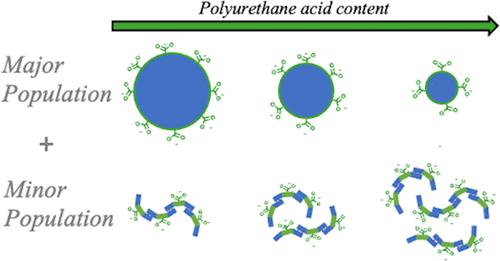当前位置:
X-MOL 学术
›
Macromolecules
›
论文详情
Our official English website, www.x-mol.net, welcomes your
feedback! (Note: you will need to create a separate account there.)
Synthesis, Morphology, and Particle Size Control of Acidic Aqueous Polyurethane Dispersions
Macromolecules ( IF 5.1 ) Pub Date : 2024-11-14 , DOI: 10.1021/acs.macromol.4c02046 Ellen J. Quane, Niels Elders, Anna S. Newman, Sophia van Mourik, Neal S. J. Williams, Keimpe J. van den Berg, Anthony J. Ryan, Oleksandr O. Mykhaylyk
Macromolecules ( IF 5.1 ) Pub Date : 2024-11-14 , DOI: 10.1021/acs.macromol.4c02046 Ellen J. Quane, Niels Elders, Anna S. Newman, Sophia van Mourik, Neal S. J. Williams, Keimpe J. van den Berg, Anthony J. Ryan, Oleksandr O. Mykhaylyk

|
A range of charge-stabilized aqueous polyurethane (PU) dispersions comprising hard segments formed from hydrogenated methylene diphenyl diisocyanate (H12MDI) with dimethylolpropionic acid (DMPA) and ethylenediamine, and soft segments of poly(tetramethylene oxide) of different molecular weights are synthesized. Characterization of the dispersions by mass spectrometry, gel permeation chromatography, small-angle X-ray scattering, atomic force microscopy, and infrared spectroscopy shows that they are composed of PUs self-assembled into spherical particles (primary population) and supramolecular structures formed by hydrogen-bonded H12MDI and DMPA acid-rich fragments (secondary population). Analysis of the scattering patterns of the dispersions, using a structural model based on conservation of mass, reveals that the proportion of supramolecular structures increases with DMPA content. It is also found that the PU particle radius follows the predictions of the particle surface charge density model, originally developed for acrylic statistical copolymers, and is controlled by hydrophile (DMPA) content in the PU molecules, where an increase in PU acidity results in a decrease in particle size. Moreover, there is a critical fractional coverage of hydrophiles stabilizing the particle surface for a given polyether soft-segment molecular weight, which increases with the polyether molecular weight, confirming that more acid groups are required to stabilize a more hydrophobic composition.
中文翻译:

酸性水性聚氨酯分散体的合成、形态和粒径控制
合成了一系列电荷稳定的水性聚氨酯 (PU) 分散体,包括由氢化亚甲基二苯基二异氰酸酯 (H12MDI) 与二羟甲基丙酸 (DMPA) 和乙二胺形成的硬链段,以及不同分子量的聚(四亚甲基氧化物)的软链段。通过质谱、凝胶渗透色谱、小角 X 射线散射、原子力显微镜和红外光谱对分散体进行表征,表明它们由自组装成球形颗粒的 PU(初级群体)和由氢键 H12MDI 和富含 DMPA 酸的片段形成的超分子结构(次级群体)组成。使用基于质量守恒的结构模型对分散体的散射模式进行分析,表明超分子结构的比例随着 DMPA 含量的增加而增加。研究还发现,PU 颗粒半径遵循最初为丙烯酸统计共聚物开发的颗粒表面电荷密度模型的预测,并受 PU 分子中亲水 (DMPA) 含量的控制,其中 PU 酸度的增加导致颗粒大小的减小。此外,对于给定的聚醚软段分子量,存在关键的亲水部分覆盖率,可稳定颗粒表面,该分子量随聚醚分子量的增加而增加,这证实了需要更多的酸基来稳定更疏水的成分。
更新日期:2024-11-14
中文翻译:

酸性水性聚氨酯分散体的合成、形态和粒径控制
合成了一系列电荷稳定的水性聚氨酯 (PU) 分散体,包括由氢化亚甲基二苯基二异氰酸酯 (H12MDI) 与二羟甲基丙酸 (DMPA) 和乙二胺形成的硬链段,以及不同分子量的聚(四亚甲基氧化物)的软链段。通过质谱、凝胶渗透色谱、小角 X 射线散射、原子力显微镜和红外光谱对分散体进行表征,表明它们由自组装成球形颗粒的 PU(初级群体)和由氢键 H12MDI 和富含 DMPA 酸的片段形成的超分子结构(次级群体)组成。使用基于质量守恒的结构模型对分散体的散射模式进行分析,表明超分子结构的比例随着 DMPA 含量的增加而增加。研究还发现,PU 颗粒半径遵循最初为丙烯酸统计共聚物开发的颗粒表面电荷密度模型的预测,并受 PU 分子中亲水 (DMPA) 含量的控制,其中 PU 酸度的增加导致颗粒大小的减小。此外,对于给定的聚醚软段分子量,存在关键的亲水部分覆盖率,可稳定颗粒表面,该分子量随聚醚分子量的增加而增加,这证实了需要更多的酸基来稳定更疏水的成分。


















































 京公网安备 11010802027423号
京公网安备 11010802027423号